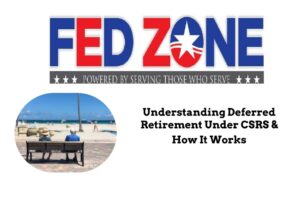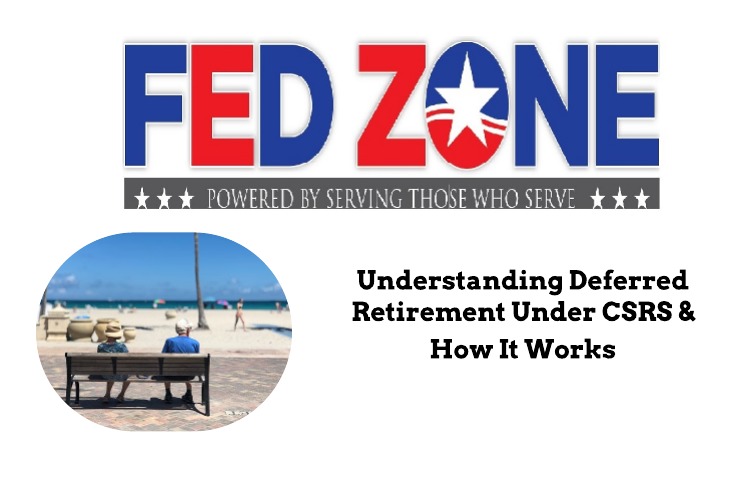Edward A. Zurndorfer
A former employee who was covered by the Civil Service Retirement System (CSRS) and who left federal service before being eligible to retire is eligible for a deferred retirement and receive a CSRS annuity if certain requirements are met. This column discusses deferred retirement under CSRS and how it works.
An employee who was covered by CSRS and separated from federal service may be eligible for a deferred retirement and receive a CSRS annuity for the rest of his or her life. There are four requirements for the former employee to receive a CSRS annuity, starting the month after the former employee becomes age 62. The former employee:
- Was not eligible for an immediate CSRS annuity within one month of separating from federal service;
- Meets the minimum civilian service requirement;
- Did not take a refund of all CSRS contributions made via payroll deduction while in federal service, at the time of separating from federal service or any time thereafter; and
- Meets the “1 out-of-2” year requirement.
Each of the requirement is discussed and explained:
Was not eligible for an immediate annuity
A separated employee who meets all of the requirements for an immediate annuity is not eligible for a deferred annuity. The following example illustrates:
Charles is 56 years old and entered federal service in 1983 after one year of military service. As of May 1, 2020, Charles has 38 years of CSRS-covered federal service. Since Charles is over age 55, he is eligible for an immediate retirement under CSRS. He is not eligible for a deferred annuity starting at age 62.
Minimum civilian service
A former CSRS employee must have completed at least five years of creditable civilian service to be eligible for a deferred retirement. Creditable civilian service for this purpose includes:
- Service for which full CSRS contributions made via payroll deductions were made, even if some of these CSRS contributions were refunded and not redeposited, except if a full refund of all contributions were made. The following examples illustrate:
Example 1. Dolores was in federal service under CSRS from 1967 through 1973 and left federal service at that time. She did not receive a refund of her CSRS contributions. She returned to federal service in 1978 and worked through 1985 at which time she again left federal service. At the time she left in 1985, she requested a refund of her CSRS contributions she made between 1978 and 1985. Dolores is eligible for a deferred retirement under CSRS because she still has six years of federal service (1967-1973) in which she did not request a refund of her CSRS contributions covering those years of service.
Example 2. Ralph was a CSRS employee from May 1, 1967 through April 30, 1972 at which time he separated. He did not ask for a refund of CSRS retirement contributions. He returned to federal service on Nov. 1, 1975 and separated on Oct. 31, 1985. At that time Ralph received a refund of his CSRS contributions covering both periods of service. When Ralph became age 62, he was not eligible for a deferred CSRS annuity because he received a refund of all his CSRS retirement contributions after separating from his last period of federal service.
- CSRS Interim or Offset service for which full Social Security (FICA) payroll taxes and reduced CSRS contributions were made.
- “Nondeduction” (temporary or intermittent service) before Jan. 1, 1984 whether or not a deposit for such service is made.
Note that any accrued and unused sick leave that a former CSRS employee had at the time of his or her separation from federal service is not creditable for both eligibility to retire and for computation of the CSRS annuity in a deferred retirement. In other words, a former employee will lose all of his or her unused sick leave hours when he or she leaves federal service.
Did not take a refund of all CSRS retirement contributions after separating from federal service
While in federal service, a CSRS-covered employee contributes a part of his or her salary each pay period to the CSRS Retirement and Disability Fund. In particular, 7 percent of the employee’s wages are contributed. Once the CSRS employee retires and receives a CSRS annuity, the total CSRS contributions the CSRS annuitant made are paid back to the annuitant over the annuitant’s life expectancy as part of the CSRS annuity. Upon leaving federal service, if the CSRS employee decides to withdraw all of his or her contributions and receive a lump sum payment, then the former employee is not eligible for a CSRS deferred retirement and no annuity will be paid.
Meets the “1 out-of-2” year requirement
The former employee must have been employed under the retirement system for at least one year within the two-year period immediately preceding the separation on which the deferred annuity is based. The following example illustrates:
William was appointed to a career position under CSRS coverage on Oct. 1, 1970. He separated on Sept. 30, 1980. He returned to a covered CSRS position on Dec. 1, 1982 and separated again in June 1983. William did not receive a refund of his retirement contributions after either separation. When William became age 62, he was eligible for a deferred CSRS annuity based only on the period between Oct. 1, 1970 and Sept. 30, 1980. The period between Dec. 1982 and June 1983 will not be included in the computation of the deferred annuity because William did not meet the “1-out-of-2” requirement with respect to this service.
What happens to an employee’s benefits upon leaving federal service?
Upon leaving federal service, an employee will be paid in a lump-sum payment for all unused annual leave hours. Any accrued and unused sick leave hours are lost and not used for the computation of the CSRS annuity.
Upon leaving federal service, a former CSRS employee will permanently lose his or her enrollment in the Federal Employees Health Benefits (FEHB) program and in the Federal Employees Group Life Insurance (FEGLI) program. Coverage will not be restored when the deferred CSRS annuity starts the month after the former employee’s 62nd birthday.
If the former employee contributed to the Thrift Savings Plan (TSP), then the former employee could have kept the TSP account and start withdrawing from it starting at age 59.5. This is if the former employee left federal service before age 55; if the former employee left federal service at age 55 or older, then he or she could have started withdrawing his or her TSP account immediately and not be subject to a 10 percent early withdrawal penalty.
Employee responsibility for receiving a deferred annuity
A deferred CSRS employee must file Form SF 1496 (Application for Deferred Retirement)downloadable at www.opm.gov/forms, about two months before reaching age 62. Note that if Form SF 1496 is not filed by the departed employee, then OPM’s Retirement Office (the form is mailed to OPM at the address on Form SF 1496) will not process the departed employee’s application. That means that no CSRS annuity will be computed by OPM’s Retirement Office. Also, no matter which age and how many years of CSRS the former employee had at the time of leaving federal service, a deferred annuity cannot start until the month after the former employee’s 62nd birthday.
Agency responsibility for a departing employee and OPM’s calculation of deferred annuity
When a CSRS employee who is not entitled to an immediate annuity separates from federal service, the employee’s agency must:
- Close out the employee’s SF 2806 (Individual Retirement Record) and forward it to OPM
- Complete SF 2810 (Notice of Change in Health Benefits Enrollment) and SF 2821 (Agency Certificationof Insurance Status).This is done to permanently terminate federal health benefits enrollment and life insurance coverage.
- If applicable, accommodate the departing employee’s request to have a refund of previously made CSRS contributions by having the departing employee fill out Form SF 2802 (Application for Refund of Retirement Contributions). The agency must notify the departing employee that if there is a refund of CSRS contributions, then the departing employee is not eligible for a deferred retirement and will not receive a deferred annuity starting at age 62.
In calculating the deferred annuity, OPM uses the following information: (1) the former employee’s years/months of federal service at the time of the employee’s departure from federal service; and (2) the former employee’s high-three average salary at the time of separation. Note that in the years between the date of separation and age 62, the high-three average salary is not adjusted by any intervening government-wide pay increases.
Those former CSRS employees who had prior military service before becoming a CSRS employee and needed to make a deposit for that military service in order to receive credit for the computation of their CSRS annuity must have done so before leaving federal service. Military service is also not used to meet the five-year minimum civilian service requirement as discussed above.
The following example illustrates the computation of a deferred CSRS annuity:
Joan, age 60, had 10 years of CSRS service from 1981 through 1991. When she left federal service in 1991, Joan did not withdraw her CSRS contributions. At the time of her separation from federal service, Joan’s high-three average salary was $60,000. Joan’s starting CSRS annuity at age 62 will be:
1.5 percent per year times five-years* times $60,000 = $4,500
+ 1.75 percent per year times five-years** times $60,000 = + $5,250
Starting Annuity $9,750
CSRS annuity formula
* 1.5 percent per year of service (years 1-5) times high-three average salary
** 1.75 percent per year of service (years 6-10) times high-three average salary
2.00 percent per year of service (10 or more years) times high-three average salary
Survivor benefits
No CSRS survivor annuity is payable to a former employee’s spouse, former spouse or children if the former employee has title to a deferred annuity but dies before attaining age 62. The same is true if the former employee attains age 62 but dies before filling out and submitting an application for a deferred retirement. The only benefit payable in either case would be a lump-sum payment of the former employee’s retirement contributions. The former employee can elect to give a CSRS survivor annuity (to a current spouse, a divorced former spouse in case of a court order, or to an insurable interest) when filling out the application for a deferred retirement.
Beneficiary forms
Former CSRS employees who are eligible for a deferred retirement are highly encouraged to make sure their beneficiary forms are filled out and up-to-date. These beneficiary forms are: (1) SF 2808 (Designation of Beneficiary of CSRS Contributions)and (2) TSP-3 (TSP Beneficiary Form).
*The profiles are hypothetical and are not intended as investment advice. Please consult with your financial advisor if you have questions about these examples and how they relate to your own financial situation.

Edward A. Zurndorfer is a CERTIFIED FINANCIAL PLANNER™ professional, Chartered Life Underwriter, Chartered Financial Consultant, Chartered Federal Employee Benefits Consultant, Certified Employees Benefits Specialist and IRS Enrolled Agent in Silver Spring, MD. Tax planning, Federal employee benefits, retirement and insurance consulting services offered through EZ Accounting and Financial Services, and EZ Federal Benefits Seminars, located at 833 Bromley Street – Suite A, Silver Spring, MD 20902-3019 and telephone number 301-681-1652. Raymond James is not affiliated with and does not endorse the opinions or services of Edward A. Zurndorfer or EZ Accounting and Financial Services. The information has been obtained from sources considered to be reliable, but we do not guarantee that the foregoing material is accurate or complete. While we are familiar with the tax provisions of the issues presented herein, as Financial Advisors of RJFS, we are not qualified to render advice on tax or legal matters. You should discuss tax or legal matters with the appropriate professional.
